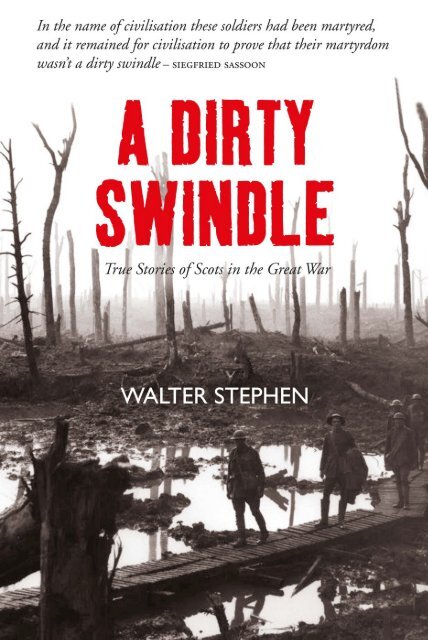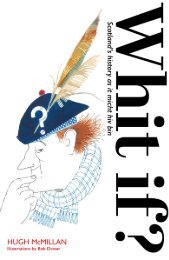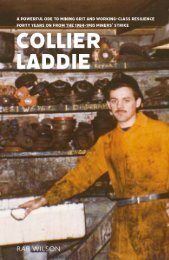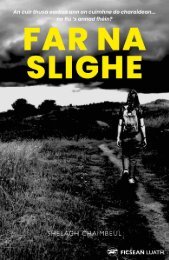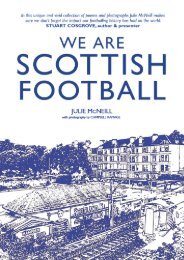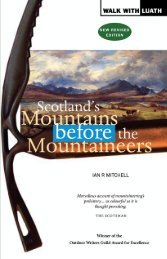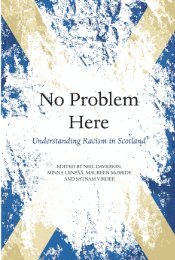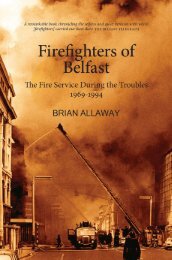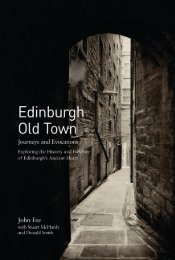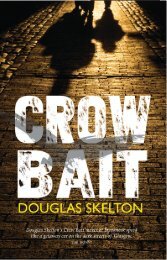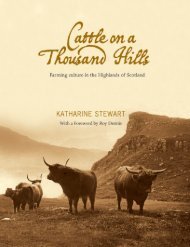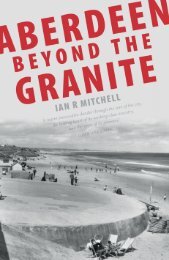A Dirty Swindle by Walter Stephen sampler
Walter Stephen provides an uninhibited look at the misery and toil of World War I through a collection of twelve stories. Providing a Scottish perspective, he takes a look at reports from home and abroad with scepticism, delving deeper to unveil the unencumbered truth. Recalling Siegfried Sassoon’s words, Stephen reveals the failures of those in command as the Great War became known as A Dirty Swindle. The varied accounts chronicle the progress of troops from recruitment to training to the frontline, as well as revealing a side of Field Marshal Haig never seen before.
Walter Stephen provides an uninhibited look at the misery and toil of World War I through a collection of twelve stories. Providing a Scottish perspective, he takes a look at reports from home and abroad with scepticism, delving deeper to unveil the unencumbered truth.
Recalling Siegfried Sassoon’s words, Stephen reveals the failures of those in command as the Great War became known as A Dirty Swindle. The varied accounts chronicle the progress of troops from recruitment to training to the frontline, as well as revealing a side of Field Marshal Haig never seen before.
Create successful ePaper yourself
Turn your PDF publications into a flip-book with our unique Google optimized e-Paper software.
walter stephen could not proceed beyond Geology i at Edinburgh University<br />
due to colour blindness – the analysis of crystals and subtle maps<br />
were hidden worlds for him. Degrees in Geography, Economic History<br />
and Education qualified him as an academic jack-of-all-trades with a<br />
lifelong devotion to environmental awareness and understanding. One<br />
of his achievements was the establishment and operation for twenty years<br />
of Castlehill Urban Studies Centre, the first successful Urban Studies Centre<br />
in Britain.<br />
A former Chairman of the Sir Patrick Geddes Memorial Trust, he has<br />
been responsible for Learning from the Lasses, A Vigorous Institution and<br />
Think Global, Act Local, collections of essays on Patrick Geddes. In his<br />
introduction to the new edition of A Herd of Red Deer he brought out<br />
the importance of Frank Fraser Darling as the founder of ecology and<br />
forerunner of David Attenborough. In The Evolution of Evolution, <strong>Walter</strong><br />
<strong>Stephen</strong> sets Darwin at the centre of a circle of Interesting Victorians. All<br />
six books, plus his biography of Willie Park Junior: The Man who took<br />
Golf to the World and <strong>Walter</strong>’s Wiggles were published <strong>by</strong> Luath Press.<br />
<strong>Walter</strong> <strong>Stephen</strong> eschews any temptation to cover old ground,<br />
instead presenting a series of uniquely Scottish and deeply<br />
individual accounts of the conflict… the author pieces together a<br />
series of personal tales that provide a valuable contribution to<br />
how the Great War is understood in the present day.<br />
Robert Tur<strong>by</strong>ne, leopard magazine<br />
This book approaches the war from different angles… particularly<br />
through the lives of certain individuals… telling the stories,<br />
warmly, directly and allowing any emotion expressed to come<br />
through the words of others. I would certainly recommend <strong>Walter</strong><br />
<strong>Stephen</strong>’s book, which has a light and deft touch, in such a painful<br />
area of history. His writing is warm, informative about so many<br />
people and places, sympathetic but never sentimental.<br />
Morelle Smith, scottish review
A <strong>Dirty</strong> <strong>Swindle</strong><br />
True Stories of Scots in the Great War<br />
WALTER STEPHEN<br />
Luath Press Limited<br />
EDINBURGH<br />
www.luath.co.uk
First published 2015<br />
This edition 2018<br />
isbn: 978-1-910745-99-1<br />
The paper used in this book is recyclable. It is made from<br />
low chlorine pulps produced in a low energy, low emissions manner<br />
from renewable forests.<br />
Printed and bound <strong>by</strong><br />
Bell & Bain Ltd., Glasgow<br />
Typeset in 11 point Sabon<br />
<strong>by</strong> 3btype.com<br />
The author’s right to be identified as author of this work under the<br />
Copyright, Designs and Patents Act 1988 has been asserted.<br />
© <strong>Walter</strong> <strong>Stephen</strong> 2015
Frontispiece ‘Shell Shock!’<br />
Anon – The Hydra
Contents<br />
Acknowledgements 9<br />
Introduction True Stories 11<br />
chapter 1 A Peace Warrior and His Family in the Great War 27<br />
chapter 2 Out of the Frying Pan 78<br />
chapter 3 Dark Lochnagar 85<br />
chapter 4 The First Hundred Thousand 90<br />
chapter 5 McCrae’s Battalion – Eponymous or Anonymous? 102<br />
chapter 6 The War Poets in the Eye of the Storm 125<br />
chapter 7 Memento Mori 144<br />
chapter 8 Their Name Liveth 154<br />
chapter 9 Observe the Sons of Ulster 160<br />
chapter 10 The Scottish National War Memorial 168<br />
chapter 11 ‘God bless the Kaiser!’ 174<br />
chapter 12 Andra and the Field-Marshal 178<br />
Bibliographical Note 187<br />
7
Acknowledgements<br />
‘A <strong>Dirty</strong> <strong>Swindle</strong>’ sets out to be good journalism – telling the truth simply<br />
– rather than scholarly exegesis. There are no boring critiques of the<br />
existing literature, no mammoth bibliographies and boastful lists of references.<br />
Pedantic footnotes are kept to the minimum. But there is a vast<br />
amount of World War i material – of very varied quality – and it is growing<br />
daily at an exponential rate. Its general value is gratefully acknowledged.<br />
Specific mention must be made of the following as opinion-formers: Seven<br />
Pillars of Wisdom (TE Lawrence, 1926), All Quiet on the Western Front<br />
(Erich Maria Remarque, 1929), Journey’s End (RC Sherriff, 1928), August<br />
1914 (Barbara Tuchman, as The Guns of August, 1962), The Face of<br />
Battle (John Keegan, 1976), The Psychology of Military Incompetence<br />
(Norman Dixon, 1976), Regeneration (Pat Barker, 1991) and War Horse<br />
(2011 film and 2007 play based on Michael Morpurgo’s book of 1982).<br />
Dr Cameron of the Patrick Geddes Archive, University of Strathclyde<br />
has steered me through that vast accumulation of documents.<br />
Grateful acknowledgement is made to Alex Geddes of New Zealand<br />
for access to his family papers and for permission to reproduce the images<br />
referred to here as figs 6 and 7. Similarly, Marion Geddes is thanked for<br />
lending me Geddes family correspondence and allowing me to reproduce<br />
Arthur’s Memorial Shrine (fig 3) and the postcard referred to here as<br />
fig 4. fig 5 is reproduced <strong>by</strong> kind permission of Ernest Press and Williamina<br />
C Barker.<br />
The Appendix from Who’s Who 1930 is reproduced <strong>by</strong> kind permission<br />
of A & C Black Publishers Ltd. The Frontispiece (‘Shell Shock!’) is reproduced<br />
with the kind permission of the Trustees of the Wilfred Owen<br />
Estate. Every reasonable attempt has been made to obtain permission to<br />
reproduce the image referred to as plate 3b.<br />
Chris Makoroski resolved certain electronic compatibility problems<br />
and Danielle Gartland-Quinn of Mortonhall Crematorium, City of Edinburgh<br />
Council saved Sir George McCrae from undeserved anonymity.<br />
9
Introduction<br />
True Stories<br />
in the book of Ecclesiastes, at Chapter 12, Verse 12 we read ‘Of making<br />
many books there is no end: and much study is a weariness of the flesh’.<br />
In autumn 2013 the Prime Minister, David Cameron, rather gauchely<br />
announced that £60 million was to be spent on ‘a celebration [of the First<br />
World War] that, like the Diamond Jubilee celebrations, says something<br />
about who we are as a people’. Since then, aided <strong>by</strong> Lord Ashcroft, the<br />
millionaire collector of Victoria Crosses, and the Daily Telegraph, there<br />
has been a steady flow of books and articles, films, plays and videos,<br />
about the war. Reminiscence has flowed and semi-forgotten and neglected<br />
monuments have been renovated or reinstated. This recent upwelling of<br />
interest in World War i is merely an upsurge in the process of retelling and<br />
analysing the story of that great struggle, a process which has gone on for<br />
almost a century, and which has produced some of the best work in literature<br />
and the visual arts.<br />
Millions died in the Great War and millions more suffered catastrophic<br />
and irritating calamities. So, most of these True Stories are also<br />
Sad Stories; some beautifully expressed, some full of incoherent emotion.<br />
Do we need another 12?<br />
John Keegan, in his masterly The Face of Battle, comments on the<br />
documentary sources for World War i:<br />
The regular battalions of the Guards and the regiments of the line added<br />
copiously to their existing histories… but humbler and more transient<br />
groups than these… at the peace vanished from public memory almost<br />
as quickly as they had been conjured into existence. It was not a deliberate<br />
act of obscuration. The regular regiments which had raised the greatest<br />
number of ‘Service’ battalions were often the least affluent (the rough<br />
rule of thumb in calculating the social status of an English regiment is<br />
that the further from London its depot, the less fashionable it will be, and<br />
the less monied its officers) and the least able therefore to stand the<br />
expense of printing a really exhaustive history.<br />
11
a dirty swindle<br />
So where does that leave the Scots? And can ‘Keegan’s Law’ be applied to<br />
all aspects of the commemoration of World War i?<br />
On Wednesday 5 August 1914, the Daily Telegraph’s main headline<br />
was ‘England’s Declaration of War against Germany’.<br />
What about Scotland? Is there nothing to be said about Wales, Ireland,<br />
Australia, Canada etc?<br />
It is still a matter of extreme irritation to me that the bands in Whitehall<br />
insist on playing ‘There’ll Always Be An England’ in the Armistice<br />
Day march-past. During the Second World War we used to sing:<br />
There’ll always be an England,<br />
As long as Scotland’s there,<br />
To do the work<br />
And share the care.<br />
Penguin Books republished Poems of the Great War in 2014; 145 pages<br />
of excellent, moving poetry. Three poems were <strong>by</strong> women. None <strong>by</strong> Scots.<br />
(John McCrae – ‘In Flanders fields the poppies blow/ Between the crosses,<br />
row on row’ – despite the name, was Canadian). So we miss, for example,<br />
‘the sheer awfulness and horror of war… simply but impressively<br />
portrayed… in the touching litany of The Glen’s Muster Roll: The<br />
Dominie Loquitur’ <strong>by</strong> Mary Symon – which supplies the emotion which<br />
parallels my observations on the quiet places in the chapter ‘Memento<br />
Mori’. This is not conscious discrimination, it is merely a consequence of<br />
the relationship between Scotland and its great neighbour, described <strong>by</strong><br />
Andrew Fletcher of Saltoun (1655–1716) as being ‘in bed with an<br />
elephant’.<br />
First World War Poets <strong>by</strong> Alan Judd and David Crane is, as one would<br />
expect from one of the National Portrait Gallery Companions series, an<br />
excellent little book. Unusually, each of the 17 poets is given his military<br />
rank and dates before a short essay recounts his life (and, too often, his<br />
death). Thus we have Captain Hon. Julian Grenfell dso (1888–1915).<br />
Each one has his portrait or photograph, almost always showing them at<br />
their best. Then comes one of his poems. (To be pedantic, only 15 are<br />
military, one was a civil servant and Lawrence Binyon – ‘They shall not<br />
grow old, as we that are left grow old’ – served at the Front with the Red<br />
Cross.) And not a Scot among them, the nearest being Second Lieutenant<br />
12
introduction<br />
AA Milne, creator of Winnie the Pooh ‘and the least military soldier imaginable’,<br />
whose father was a Scot who moved to London.<br />
There may be a problem of class. In a big article in the Sunday Telegraph<br />
(‘The Path from Playing Fields to Flanders Fields’) Jeremy Paxman<br />
looks at ‘the vital role schools and their pupils played in the First World<br />
War’:<br />
He points out that more than 1,000 Etonians never returned from the<br />
war, and… that there can hardly have been a school in the country that<br />
did not send its own contingent of young men to perish, including nearly<br />
700 from Rug<strong>by</strong> and Cheltenham… from Winchester… and 450 from<br />
other second-division public schools such as Malvern and Uppingham.<br />
‘Headmasters… were broken’, but there is no reference, for example, to<br />
the likes of Mary Symon’s country headmaster mentioned above. Are we<br />
to imagine that the bulk of the 20,000 killed on 1 July 1916 did not attend<br />
school? Twenty senior students from Broughton Higher Grade School in<br />
Edinburgh were led in to McCrae’s Battalion <strong>by</strong> their bespectacled mathematics<br />
teacher Peter Ross. Were there others like that? Nor does Paxman<br />
mention that the high death rate among young officers was not due to<br />
chance, but <strong>by</strong> their being distinctively accoutred and armed. Thus, enemy<br />
snipers were able to take out the officers first, leaving the squaddies leaderless<br />
and in confusion.<br />
Sir Hew Strachan, Chichele Professor of the History of War, Fellow at<br />
All Souls College, Oxford and a member of the World War i Centenary<br />
Advisory Board, has similar anxieties. He maintains that the educational<br />
ambition behind the centenary is not being met and that we are being<br />
presented with ‘a British war and one fought almost exclusively against<br />
Germany’. Local projects have stimulated local interests ‘but they hardly<br />
match the war’s scale’ and, for example, in setting up ‘Engagement<br />
Centres’:<br />
Not even a national spread has been achieved, as the most northerly of<br />
the recipients is Nottingham, and, while Northern Ireland is covered,<br />
Wales and Scotland are not.<br />
While I agree with Sir Hew and am conscious that these True Stories are<br />
essentially local and small-scale, I think it will be clear that there are<br />
bigger issues raised in most of them. And, as Martin Luther said when he<br />
protested against the evils of the Church – ‘I can do no other!’<br />
13
a dirty swindle<br />
Although I have never fired a shot in anger, I could be described as a<br />
trained professional killer and as having some understanding of the military<br />
mind. Thousands of us, still alive, are criticised for creating a pensions<br />
crisis <strong>by</strong> living too long. Yet we gave up two years of our lives in the<br />
National Service of our country while others, of poor health, or in supposedly<br />
valuable occupations, or in Northern Ireland, stayed at home and<br />
built themselves nice little careers, thank you. For the first 16 weeks of<br />
basic training we were paid four shillings (20 pence) a day, although this<br />
increased with service, additional qualifications and, perhaps, promotion.<br />
Bed, board and uniform were provided, but for those fortunate enough<br />
to be commissioned, a tailor and a hatter came down from London to fit<br />
us for our service dress and mess dress, for which we had to pay.<br />
Almost all of the regulars at that time had served in the Second World<br />
War and a glance at their medal ribbons told one what they had been up<br />
to. Or rather, where they had been. For example, the Burma Star was<br />
awarded for service in Burma between certain dates, or in Bengal or<br />
Assam between certain other dates, or in China or Malaya between other<br />
dates. But they give no indication of the quality of service!<br />
Everyone had the Defence Medal and the War Medal. A chap with the<br />
Africa Star would have a clasp with an ‘8’ for Eighth Army, or a ‘1’ for<br />
the First Army, and an Italy Star, and a France and Germany Star. In<br />
1952–54 there was fighting in Korea and in Malaya, and fresh ribbons<br />
from these campaigns were much in evidence. Those who had been in<br />
Korea had two medals: the British Korea Medal and the United Nations<br />
Korea Service Medal.<br />
The Victoria Cross and the Military Cross will come up again. I served<br />
under two captains who wore the ribbon for the mc. They were both<br />
small, vital men who contrived to be enthusiastic in their dull peacetime<br />
roles. For 13 Command Workshops, reme – a huge garage in uniform –<br />
one was the scrum half in the Rug<strong>by</strong> team. He and I (in the forwards)<br />
were the pillars of the team but this did not diminish his occasional justified<br />
criticisms of the performance of my duties. The other was assiduous<br />
in trying to persuade me to ‘sign on’ as a regular.<br />
Captain Stagg, Royal Artillery, who had just returned from Korea,<br />
was the Chief Instructor of my section at Mons Officer Cadet School. On<br />
manoeuvres, when it was my turn to command the section, he was kind<br />
enough to say that my leadership would have earned me the mc in action.<br />
14
introduction<br />
Very gratifying, but one wonders just how one would have behaved if the<br />
situation had been real and ‘the guns began to roar’.<br />
The initial basic training of 16 weeks was fairly strenuous, rather<br />
noisy, but confidence-building for most. There was hectoring and some<br />
bullying. There were ‘accidents’ on the rifle range. Some fellows tried to<br />
‘work their ticket’, trying to get discharged on account of poor health,<br />
psychological unsuitability or <strong>by</strong> shooting themselves in the foot – an<br />
offence ‘punishable <strong>by</strong> death or any less penalty that the court martial<br />
may impose’. There was the occasional suicide. I spent a rather enjoyable<br />
period jaunting round Britain and bringing back prisoners – mostly poor<br />
souls who had overstayed their leave (usually because of some girl) and<br />
had been picked up <strong>by</strong> the police. Very romantic and dramatic on the<br />
stage in Bizet’s Carmen, but all very pathetic in real life.<br />
The regimental depot where the trained soldiers waited till they were<br />
posted to their units was not a happy place. A wee corporal of the Seaforth<br />
Highlanders supplemented his pay <strong>by</strong> soliciting backhanders from those<br />
wanting a nice posting near home, and certainly not in the Empire’s<br />
hotspots. In 1952 there was still rationing and many a seven-pound tin of<br />
ham found its way from the cookhouse or the stores to the town.<br />
‘Those bloody Jocks’ had their value in Aldershot. Before the motorway<br />
network was built, a fleet of coaches would pick up hundreds of<br />
troops at tea-time on Friday and hurry them off to places like Leicester,<br />
Birmingham and Manchester. From Sunday night at midnight they would<br />
bring back the unhappy weekenders, who proceeded to spend most of<br />
Monday sleeping on whatever job they were supposed to be doing. The<br />
Jocks were useful in that they could look after the shop, releasing these<br />
others for their 36- and 48-hour passes, for certain favours. On the<br />
weekend of the Coronation, the entire British Army was either lining the<br />
route or off on leave, and I really believe that, in Aldershot at least, the<br />
only people on duty were an elderly major in the Royal Pavilion (who had<br />
no home to go to) and myself!<br />
Once they got to their units, many of the technical squaddies settled<br />
into jobs not too unlike those they might have been doing in ‘civvy’ street<br />
(the infantry and cavalry were different) and it was a question of serving<br />
out one’s time without too much trouble to oneself or to others – ‘one day<br />
more, one day less.’ ‘Roll on demob.’ Grumbling and a sense of humour<br />
were the two safety valves which kept the bulk of the armed services going.<br />
15
a dirty swindle<br />
Do these snapshots of military life in the 1950s shed any light at all<br />
on what it was like to serve in World War i? The first shock of war was<br />
borne <strong>by</strong> the regulars and territorials. Then came the troops from the<br />
Empire (not the Commonwealth) and the volunteers, like Kitchener’s<br />
‘First Hundred Thousand’ and the ‘Pals battalions’. But <strong>by</strong> 1916 the pot<br />
of enthusiasm had been scraped bare, and it was conscription that filled<br />
the gaps and created the force that eventually wore the enemy down. In<br />
my time the armed services were vast and complex, headed up and led <strong>by</strong><br />
regulars, almost all of whom had served in World War ii, and had been<br />
decorated accordingly. But they were clearly not all heroes and it is facilely<br />
sentimental to suppose that all those who fought and died in World War<br />
I were heroes as well.<br />
We were spared two unsettling uncertainties. It was most unlikely that<br />
many of us would be killed, while most of our Great War equivalents<br />
would see action – and its consequences. We also knew how long we were<br />
going to serve (although at one point National Service doctors were not<br />
allowed to be demobilised because they could not be replaced). It was<br />
clear <strong>by</strong> the end of August 1914 that the war would not be over <strong>by</strong> Christmas<br />
and every year had its ‘big push’ – Loos in 1915, the Somme in 1916,<br />
Passchendaele in 1917 – after each of which there was still ‘a long, long<br />
trail a-winding’. When the Germans broke through in early 1918 it must<br />
have seemed that the war would never end.<br />
The traditionalists object to Oh! What a Lovely War, Blackadder and<br />
some of the war poetry as being defeatist, unpatriotic and disrespectful of<br />
the dead. I think they miss the point – which is that it is, as I said earlier,<br />
through grumbling, through little acts disrespectful of authority and, above<br />
all, through humour, that ordinary folk cope with the realities of war.<br />
I sometimes have anxieties about what might be called the cult of the<br />
Victoria Cross. As George MacDonald Fraser puts it in The General<br />
Danced at Dawn:<br />
There are… ‘good vcs’ and ordinary vcs – so far as winning the vc can<br />
ever be called ordinary… I imagine if it were possible to take a poll of the<br />
most famous vcs over the past century Piper George Findlater would be<br />
challenging for the top spot… what he did on an Afghan hillside one<br />
afternoon caught the public imagination, as it deserved to, more than<br />
such things commonly do.<br />
The pipe-sergeant recounts:<br />
16
introduction<br />
The pipers was out in front – as usual – and Findlater was shot through<br />
first one ankle then through the other, and fell among the rocks in front<br />
of the Afghan positions. And he pulled himself up, and crawled to his<br />
pipes, and him pourin’ bleed, and got himself up on a rock wi’ the shots<br />
pingin’ away round him, and played the regimental march so that the<br />
boys took heart and carried the crest.<br />
What made Findlater’s deed special was not just his personal courage but<br />
the fact that attacks earlier in the day <strong>by</strong> county regiments and the<br />
Gurkhas had been repulsed, but the Gordons had been so encouraged <strong>by</strong><br />
the ‘Cock o’ the North’ that they succeeded where the others had failed.<br />
The Heights of Dargai caught the public imagination. Pictures were<br />
painted and prints made. ‘Cock o’ the North’ was sounded up the length<br />
and breadth of the land, in music-halls, and <strong>by</strong> brass bands, and <strong>by</strong> street<br />
fiddlers. The butcher boys in the street whistled it and sang it to naughty<br />
words. The Queen travelled down to Netley Hospital in Hampshire to pin<br />
the vc on the hero.<br />
I feel a certain relationship with Findlater and his great deed. My<br />
grandfather was one of the heroes that day and met Findlater later, after<br />
South Africa. In Edinburgh, in 1947, my pal Eddy Wilson would go up to<br />
the top flat and take down the ash-bucket of Findlater’s sisters. Under it<br />
there was always a shiny new penny.<br />
But there were other vcs won that day on the Heights of Dargai.<br />
Private Lawson (an Englishman in the Gordons):<br />
Carried Lieutenant Dingwall (who was wounded and unable to move),<br />
out of a heavy fire, and subsequently returned and brought in Private<br />
McMillan, being himself wounded in two places.<br />
When an officer of:<br />
The Der<strong>by</strong>shire Regiment was struck down, Lieutenant Pennell ran to his<br />
assistance and made two attempts, under a hail of bullets, to carry and<br />
drag him back to cover. The Lieutenant only gave up when he found that<br />
the wounded officer was dead.<br />
Private Vickery of the Dorsetshires:<br />
Ran down the slope and rescued a wounded comrade under heavy fire,<br />
bringing him back to cover.<br />
Findlater is remembered, the others not. Why? Findlater was a ‘good’ vc<br />
because he not only showed courage, but his actions influenced (or were<br />
17
a dirty swindle<br />
believed to have influenced) the course of the engagement. For the others,<br />
it is very important for morale to know that the wounded will not be left<br />
to die out there between the lines, and therefore those who bring them in<br />
are carrying out a constructive and humane act in a general sense, but are<br />
probably not achieving the military objectives of the action in any way.<br />
Sassoon probably had his tongue in his cheek when he said of the action<br />
for which he received his mc:<br />
It was only the sort of thing which people often did during a fire or a<br />
railway accident.<br />
We can see what he means.<br />
The Sunday Telegraph devoted two pages, with photographs, to<br />
Private George Peachment (18) who, after a failed attack in the Battle of<br />
Loos, ‘Showing great bravery… went to the aid of his officer who had<br />
been seriously wounded’. The citation for the medal said:<br />
He knelt in the open <strong>by</strong> his officer and tried to help him, but while doing<br />
this he was first wounded <strong>by</strong> a bomb and a minute later mortally<br />
wounded <strong>by</strong> a rifle bullet. He was one of the youngest men in his battalion,<br />
and gave this splendid example of courage and self-sacrifice.<br />
His officer, Captain Guy Dubs, survived (someone else must have brought<br />
him in) and recommended Peachment for the vc. He wrote twice to Mrs<br />
Peachment saying to her that he had made George his orderly just before<br />
the battle in an attempt to prevent him having to go over the top. He<br />
confessed:<br />
I am afraid I feel very responsible for his death, because I might have sent<br />
him home a short time before when I found out his age, only he was so<br />
keen to stay.<br />
I wonder if I am alone in feeling that, amid all the terror and courage of<br />
battle, where scenes like this must have been replicated many times, there<br />
is something uncomfortable in this award and in Michael Ashcroft’s title<br />
for his article – ‘No man could have been braver’.<br />
In the Lewis Grassic Gibbon Centre in Arbuthnott there is an interesting<br />
little display referring to Lance Corporal Robert Walker of the 1st<br />
Gordon Highlanders. On 26 August 1914 he carried a wounded comrade<br />
called Addlestone for three miles behind the German lines. On 13 October<br />
he was shot in the head <strong>by</strong> the enemy and died in St Mark’s College<br />
Hospital in London on 25 October. In a glass case are his three standard<br />
18
introduction<br />
World War i medals, the ‘Widow’s Penny’, and a very attractive Médaille<br />
Militaire. A framed certificate from the President of France records that<br />
Walker had been awarded the Médaille Militaire for his courage in action.<br />
Odd, isn’t it?<br />
From the Great War, Zeebrugge is an interesting case study. Early in<br />
1918 the U-boat campaign had brought Britain almost to its knees, and<br />
it was decided that the Flanders flotilla of the Imperial German Navy<br />
should be locked into its Zeebrugge base. My Pageant of the Century of<br />
1933 covers the raid in four pages, with 11 photographs. It says:<br />
Admiral Sir Roger Keyes was the executive to whom the Zeebrugge operation<br />
was entrusted. With consummate skill he succeeded in sinking the<br />
vessels designated to form the block inside the Mole… and a landing<br />
party did magnificent work on the Mole… [German] headquarters staff<br />
officers rushed to Zeebrugge to direct the defence against the British<br />
attack, but the precision with which the carefully drawn plans were<br />
carried out rendered all German efforts abortive.<br />
In part nine of the Sunday Telegraph’s ‘Inside the First World War’ series,<br />
a double page is devoted to Zeebrugge. When the attack came, on 22<br />
April, it was at the fourth attempt, ‘as the weather and wind direction had<br />
conspired against us’. ‘The events of that night were dramatic and, at<br />
times, confused’. An old cruiser, hms Vindictive, and two old Mersey ferry<br />
boats were sunk – but in the wrong place – and a storming party of Royal<br />
Marines landed on the Mole. A parallel attack was made on Ostend, but<br />
was called off.<br />
The canal was opened up again after two days. The British suffered 227<br />
dead and 356 wounded. German losses were eight dead and 16 wounded.<br />
The British suffered 47 casualties at Ostend compared with just 11 for<br />
the enemy. There is no doubt, however, that there were many cases of<br />
incredible bravery <strong>by</strong> individuals and the raid resulted in the award of<br />
three vcs and numerous other gallantry awards.<br />
And eight vcs were awarded for Zeebrugge.<br />
How can we strike a balance sheet for Zeebrugge? On the one hand,<br />
600 casualties for a very temporary advantage. On the other, 11 examples<br />
of heroic behaviour in the hurly-burly of war.<br />
A <strong>Dirty</strong> <strong>Swindle</strong>: True Stories of Scots in the Great War is not an attack<br />
on Mr Cameron, Lord Ashworth and the Daily Telegraph. The Great War,<br />
as we called it in my young days, was clearly such a cataclysmic event that<br />
19
a dirty swindle<br />
everyone should know about it and its effects – on the world, not just<br />
Britain. It is good that the public should be reminded and informed about<br />
events, that communities and individuals be involved in research and<br />
commemoration, and that what arose out of the ashes of war be considered.<br />
But the task is vast and there is a need for the occasional qualification<br />
or redirection. So A <strong>Dirty</strong> <strong>Swindle</strong> is unashamedly Scottish, and<br />
homes in on some interesting angles which are often ignored or forgotten<br />
in the face of the major tragedy.<br />
Siegfried Sassoon knew a thing or two about the Great War, and it was he<br />
who described it as ‘a dirty swindle’. In King Richard II Shakespeare writes:<br />
For God’s sake, let us sit upon the gro und<br />
And tell sad stories of the death of kings:<br />
How some have been depos’d, some slain in war,<br />
Some haunted <strong>by</strong> the ghosts they have depos’d,<br />
Some poison’d <strong>by</strong> their wives, some sleeping kill’d;<br />
All murdered.<br />
There follow True Stories aplenty, of subjects of kings and emperors, slain<br />
in war and in a variety of different ways. Some poisoned <strong>by</strong> gas, some<br />
killed while they slept. And there are ghosts and nightmares. Were they<br />
all murdered? Or did they give up their lives willingly? Impossible to give<br />
one answer that fits all. No attempt is made to milk the misery of war, the<br />
facts are miserable enough as they stand.<br />
And yet the last two True Stories remind us of the complexities of the<br />
great conflict and the resilience of the human spirit in coming through the<br />
most frightful experiences. Here is an overview of the themes explored in<br />
this book, chapter <strong>by</strong> chapter.<br />
‘A Peace Warrior and His Family in the Great War’ is centred around<br />
Patrick Geddes (1854–1932), ‘a most unsettling person’, a world figure<br />
who has been summarised as ‘Biologist, Town Planner, Re-educator, Peacewarrior’.<br />
He and six members of his family were involved in the Great<br />
War, were affected <strong>by</strong> it and tried to do something about preventing it,<br />
winning it or mitigating its worst effects. They are of interest because each<br />
member played a distinctive role – if minor – in the great drama that was<br />
played out across the world.<br />
‘Out of the Frying Pan’ is the saddest of stories, of the 1/7th (Leith)<br />
Battalion of the Royal Scots, whose troop train from Larbert to Liverpool<br />
20
introduction<br />
(for Gallipoli) crashed at speed and went on fire at Quintinshill, near<br />
Gretna, in Britain’s worst train accident. The survivors were scraped<br />
together and with numbers made up from other units formed the 4th and<br />
7th Royal Scots. In Gallipoli, 37 days after the rail disaster, they took part<br />
in a massive and costly attack on the Turkish positions. A further horror<br />
has to be recorded. The Mediterranean scrub and grass was set on fire and<br />
swept across no-man’s land, where the poor wounded suffered a horrible<br />
death within earshot of their comrades. Some had survived the frying pan<br />
of Quintinshill only to be consumed in the fire of Gallipoli.<br />
‘Dark Lochnagar’ takes its title from a big mountain in Aberdeenshire,<br />
visible from a great distance and with great sentimental associations.<br />
Byron celebrated it in poetry, Queen Victoria climbed it. On the first day<br />
of the Somme, the Lochnagar Mine(s) failed to make the advance of<br />
McCrae’s Battalion an easy stroll. In St Giles Cathedral, Edinburgh, in<br />
1923, at the unveiling of the memorial to McCrae’s Battalion, Pipe Major<br />
Willie Duguid piped up Dark Lochnagar.<br />
The beauty of the winter solitude of Lochnagar contrasts so strongly<br />
with the sordid reality of ‘Man’s inhumanity to man’.<br />
The next three chapters form a kind of triptych in that they each derive<br />
mainly from a book, but each subject is dealt with in its own style. The individual<br />
narratives are interesting, but considered together they raise questions<br />
about truth, the nature of evidence and the appropriate style for reminiscence.<br />
‘The First Hundred Thousand’ takes its title from a book <strong>by</strong> ‘Ian Hay’,<br />
the nom de plume of Captain Beith, describing the recruiting, training and<br />
first major action of a fictional Highland regiment (based on the Argyll<br />
and Sutherland Highlanders, in which the author served). It is straightforward<br />
and displays the qualities of grumbling and humour I have<br />
praised earlier.<br />
It concludes with the Battle of Loos, which began on 25 September<br />
1915. (In ‘real life’ Beith made it to Major, won the Military Cross at Loos<br />
– not mentioned in the book – and was Mentioned in Dispatches.) The<br />
book was a publishing tour de force in that it came out before the end of<br />
1915. Much of it must have been written ‘on the hoof’ and in the trenches<br />
and, as evidence, must rank very highly in terms of truth. Today’s literati<br />
may consider it trivial and naïve, but his final message is loyal and optimistic,<br />
but prophetic. Hay’s voice must be respected for its immediacy.<br />
‘McCrae’s – Eponymous or Anonymous?’ tells the story of Sir George<br />
21
a dirty swindle<br />
McCrae’s rise from obscurity to success as a businessman and politician,<br />
and of the 16th Battalion of the Royal Scots, a Service Battalion which<br />
was raised and led <strong>by</strong> the charismatic McCrae.<br />
Around 1990 one Jack Alexander found that virtually all the battalion’s<br />
records had been destroyed. None of Edinburgh’s many museums,<br />
libraries or archives seemed to hold a single item. Fortunate that some<br />
survivors were still alive, he worked for 12 years to produce probably the<br />
best record there is of a Service Battalion – McCrae’s Battalion: The Story<br />
of the 16th Royal Scots. From documents, letters, photographs and interviews<br />
he built up a readable history of scholarly quality.<br />
The contrast in approach with The First Hundred Thousand could<br />
hardly be greater, but both rank highly in terms of integrity and honesty.<br />
Alexander must have been pleased that McCrae’s Battalion was rescued<br />
from anonymity <strong>by</strong> Jeremy Paxman, who devoted a ten minute slot in one<br />
of his World War I programmes to the recruiting of McCrae’s and the<br />
example set <strong>by</strong> the Hearts footballers.<br />
‘The War Poets in the Eye of the Storm’ focuses on the best-known<br />
War Poets, Siegfried Sassoon and Wilfred Owen, who each spent several<br />
months in the Slateford Military Hospital for shell-shocked officers in<br />
Edinburgh. Much of what we know about this important encounter<br />
comes from Siegfried Sassoon who, after a decade or so of poetry,<br />
published Memoirs of a Fox-Hunting Man, which won the 1928 James<br />
Tait Black Award for fiction. Yes, fiction. In 1930 Memoirs of an Infantry<br />
Officer followed, then Sherston’s Progress in 1936. The three books were<br />
published together in 1937 as The Complete Memoirs of George Sherston.<br />
George Sherston is, of course, a thinly disguised Sassoon and his<br />
trilogy is a beautifully written account of how he came to be in Craiglockhart,<br />
what it was like to be there and what happened after.<br />
A comparison of the three books is a fascinating task. Ian Hay’s book<br />
is fresh, but perhaps too conformist and optimistic for some. Sassoon is<br />
describing events of more than ten years before, and memory is notoriously<br />
unreliable and selective, while Jack Alexander has no experience of<br />
war against which to measure the testimony of his subjects.<br />
‘Memento Mori’ is a thoughtful chapter devoted to the examination<br />
of war memorials; particularly in the rural and remote corners of Scotland,<br />
where the death toll was high, and one feels the losses hastened<br />
depopulation and the emptying of the glens.<br />
22
introduction<br />
‘Their Name Liveth…’ describes how I stumbled across two military<br />
cemeteries on opposite sides of Edinburgh. Each was associated with a<br />
near<strong>by</strong> military hospital. One is exemplary in its neatness, maintenance<br />
and discreet information, while the other is neglected, with the stones all<br />
awry and the ground unkempt. In one, the True Stories may be mitigated<br />
a little <strong>by</strong> the respectful treatment of the dead. In the other, one smiles<br />
cynically at the inscription ‘Their Name Liveth for Ever’ and muses on the<br />
difference between public recognition and private forgetfulness.<br />
‘Observe the Sons of Ulster…’ takes us to Londonderry in Northern<br />
Ireland, a city with strong links to Scotland, where, in 2008, long before<br />
Mr Cameron, Lord Ashcroft and the Daily Telegraph, the Diamond War<br />
Memorial Project researched and published information on the 756 individuals<br />
from the city whose names are recorded on the Diamond War<br />
Memorial.<br />
Given the political climate in Ireland in 1916, many Ulstermen, fearful<br />
of reprisals to their loved ones, crossed the North Channel to enlist in<br />
Scottish regiments. The First of July was already a special day, a day full<br />
of symbols, songs and slogans for the Sons of Ulster. Thus, in Northern<br />
Ireland, the first day of the Battle of the Somme acquired an especial<br />
significance, as on that day the Ulster Division incurred fearful losses<br />
while doing better than most.<br />
‘The Scottish National War Memorial’ looks at the memorial situated<br />
on the highest point of the Edinburgh Castle Rock, an old Army barrack<br />
turned into a dignified national monument and shrine devoted to those<br />
who died for their country in the Great War. (Subsequent conflicts have<br />
been unobtrusively recognised.)<br />
Visited <strong>by</strong> crowds of camera-carrying tourists of all nations, it still<br />
invokes an atmosphere of respect and bewilderment at the terrible scale<br />
of the losses commemorated there and the vast complexity of modern<br />
war. There is no triumphalism, only perhaps a perfectly understandable<br />
idealism of those who served and the cause for which they died.<br />
The last two chapters are True Stories, revealing that, in the midst of<br />
sadness, there is still some good to be found.<br />
‘God bless the Kaiser’ reminds us that, amid all the death and destruction<br />
and while every community had its losses, for some the Great War<br />
brought much-needed benefits. ‘Now thrive the armourers’ says The<br />
Prologue in Henry V and, of course, the war profiteers did very nicely and<br />
23
a dirty swindle<br />
picked up substantial rewards, both financial and in honours from a<br />
grateful nation. Isaac Rosenberg – whom some consider as the finest of<br />
the War Poets – returned from South Africa and enlisted in 1915. ‘His<br />
main concern was for the parlous finances of his family’. He was probably<br />
not the only one. The war brought food shortages and high prices, so that<br />
small ports with their inshore fisheries received a welcome boost to their<br />
dying activities. Part of the sadness is that we had to have a war for these<br />
things to happen and that ‘the land fit for heroes’ failed to materialise.<br />
Field Marshal Haig has been vilified for having been an insensitive<br />
butcher who sent the youth of the nation to their deaths, a polo-playing<br />
buffoon out of touch with the reality of war and those who fought in it,<br />
a conservative leader resistant to and unable to change.<br />
‘Andra and the Field-Marshal’ is a post-war snapshot which reveals<br />
that Haig had more to him than the highly-polished boots of the cavalryman.<br />
More than that, it reveals that Haig – and presumably many more –<br />
had a resilience that helped him to set aside the terrible traumas of conflict.<br />
Emotion does not shine through these True Stories. One thinks back<br />
to the spring of 2010, when the eruption of a fairly small volcano in<br />
Iceland caused a volcanic ash cloud which affected most of Europe and<br />
perhaps 10,000,000 air passengers. One recalls the scenes at Glasgow<br />
Airport with irritated and harassed passengers. And one recalls one<br />
Glasgow man, with his trolley piled high with luggage, saying – ‘You<br />
cannae be angry wi’ a volcano.’ It’s too big and completely beyond our<br />
control. Similarly, it could be said that you cannot be angry about the<br />
Great War. It’s too big, it was always beyond control and, anyway, it was<br />
a long time ago and far away.<br />
Nevertheless, there is emotion in the writing of these True Stories. One<br />
cannot compete with the imagination of Pat Barker or the clever irony of<br />
Oh What a Lovely War! But one can certainly feel the anger at the inhumanity<br />
of someone like ‘Hunter-Bunter’ – who sent the Royal Scots’ survivors<br />
from the Gretna disaster into the hell of Gallipoli just 37 days later,<br />
and did almost the same thing, but on a bigger scale, the following year<br />
in Flanders – and contempt for the sustained dishonesty and lack of supervision<br />
of the railwaymen responsible for the disaster. One almost weeps<br />
at the thought of Mrs McClay asking Daisy McBride’s mother to sit with<br />
her on the anniversary of the day her three sons were killed. Or the rage<br />
at the old men, and especially the despot Franz Josef, who had the power<br />
24
introduction<br />
to use other means to resolve their jealousies and had not the wit or care<br />
for their subjects to do so. Or sense the perplexity of the ageing Peace<br />
Warrior grieving for his son, proud of his achievement, yet unable to<br />
break the news to the dying mother.<br />
Mary Symon’s dominie concludes his soliloquy:<br />
For every lauchin’ loon I kent I see a hell-scarred man.<br />
Not mine but yours to question now! You lift unhappy eyes –<br />
‘Ah, Maister, tell’s fat a’ this means.’ And I, ye thocht sae wise,<br />
Maun answer wi’ the bairn words ye said to me langsyne:<br />
‘I dinna ken, I dinna ken.’ Fa does, oh, Loons o’ Mine?<br />
Are we any the wiser today?<br />
25
Luath Press Limited<br />
committed to publishing well written books worth reading<br />
luath press takes its name from Robert Burns, whose little collie Luath (Gael.,<br />
swift or nimble) tripped up Jean Armour at a wedding and gave him the chance to<br />
speak to the woman who was to be his wife and the abiding love of his life.<br />
Burns called one of ‘The Twa Dogs’ Luath after Cuchullin’s<br />
hunting dog in Ossian’s Fingal. Luath Press was established<br />
in 1981 in the heart of Burns country, and now resides<br />
a few steps up the road from Burns’ first lodgings on<br />
Edinburgh’s Royal Mile.<br />
Luath offers you distinctive writing with a hint of<br />
unexpected pleasures.<br />
Most bookshops in the uk, the us, Canada, Australia,<br />
New Zealand and parts of Europe either carry our books<br />
in stock or can order them for you. To order direct from<br />
us, please send a £sterling cheque, postal order, international<br />
money order or your credit card details (number, address of<br />
cardholder and expiry date) to us at the address below. Please add<br />
post and packing as follows: uk – £1.00 per delivery address; overseas<br />
surface mail – £2.50 per delivery address; overseas airmail –<br />
£3.50 for the first book to each delivery address, plus £1.00 for each<br />
additional book <strong>by</strong> airmail to the same address. If your order is a gift, we will happily<br />
enclose your card or message at no extra charge.<br />
Luath Press Limited<br />
543/2 Castlehill<br />
The Royal Mile<br />
Edinburgh EH1 2ND<br />
Scotland<br />
Telephone: 0131 225 4326 (24 hours)<br />
email: sales@luath.co.uk<br />
Website: www.luath.co.uk<br />
ILLUSTRATION: IAN KELLAS


